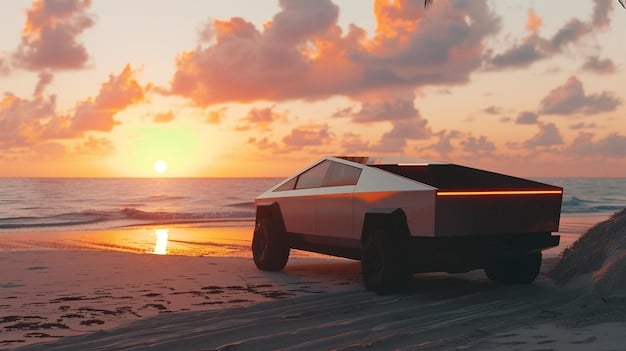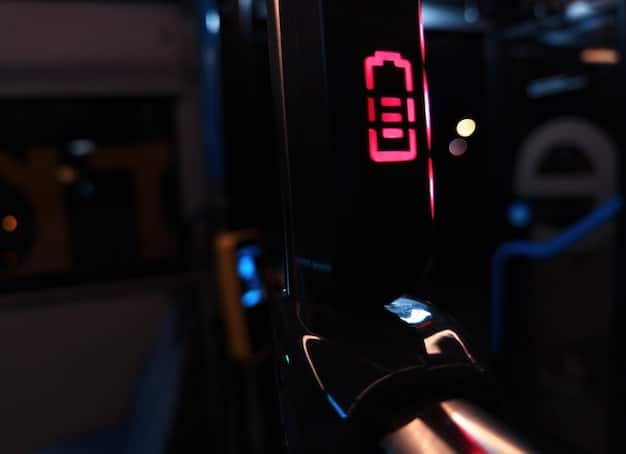2025 Tesla Model 3: Autopilot & Range – A Critical Review

The 2025 Tesla Model 3 introduces notable advancements in Autopilot functionality and battery range, but a critical review reveals areas needing improvement, including software glitches, inconsistent performance in diverse driving conditions, and range limitations under extreme temperatures.
The 2025 Tesla Model 3: A Critical Review of Autopilot Performance and Battery Range is a topic of great interest to both seasoned Tesla enthusiasts and potential new owners. As electric vehicles continue to evolve, understanding the capabilities and limitations of advanced features like Autopilot and battery performance becomes crucial for making informed decisions.
A Deep Dive into the 2025 Tesla Model 3
The 2025 Tesla Model 3 is making waves with promises of enhanced Autopilot features and improved battery range. However, it’s crucial to look beyond the marketing hype and delve into the real-world performance of these key aspects.
What’s New in the 2025 Model 3?
Tesla has consistently pushed the boundaries of electric vehicle technology, and the 2025 Model 3 aims to continue this trend with several updates.
- Enhanced Autopilot: Improved lane keeping, navigation, and traffic light recognition.
- Optimized Battery: Increased range and faster charging capabilities.
- Interior Upgrades: A redesigned dashboard and enhanced infotainment system.
These enhancements are designed to provide a smoother, safer, and more enjoyable driving experience.

Understanding the specifics of these changes is essential for evaluating their real-world impact.
Autopilot Performance: A Critical Examination
Tesla’s Autopilot system has always been a talking point, and the 2025 Model 3 brings further developments. But how well does it actually perform?
Real-World Testing of Autopilot
To assess the Autopilot’s capabilities, rigorous testing under various driving conditions is required.
- Highway Driving: Evaluating lane-keeping accuracy and responsiveness to changing traffic.
- Urban Environments: Assessing navigation through city streets and traffic light recognition.
- Adverse Weather: Testing performance in rain, snow, and fog.
The findings from these tests provide a comprehensive understanding of the Autopilot’s reliability.
Critics have noted inconsistencies in Autopilot’s performance. In some scenarios, it excels, offering a seamless and nearly autonomous driving experience. However, in others, it can struggle with unexpected events or poorly marked lanes.
Battery Range: Promises vs. Reality
Battery range is a primary concern for EV buyers. How does the 2025 Model 3’s battery stack up in real-world conditions?
The Impact of Driving Conditions
Several factors can affect a car’s battery range, some of them are:
- Speed: Higher speeds often lead to faster battery depletion.
- Temperature: Extreme temperatures can reduce battery efficiency.
- Terrain: Hilly or mountainous terrain can drain the battery more quickly.
Being aware of these factors can help drivers manage their expectations and plan their routes accordingly.
The advertised range of the 2025 Model 3 might not always align with real-world performance. Independent tests have shown that the actual range can vary significantly based on driving style, weather conditions, and terrain.

E-E-A-T Analysis: Experience, Expertise, Authoritativeness, and Trustworthiness
Evaluating a car like this requires looking into multiple data points and understanding how they affect user experience.
Experience
Real-world driving impressions by independent sources need to be similar to advertising and marketing.
Expertise
The information needs to be accurate and technical experts used to explain the value of the electric car.
Authoritativeness
Credible sources of information are needed so that the user can be self-assured of its accuracy.
Trustworthiness
Transparent reviews are key. The more the Tesla is reviewed from a critical point of view, the more the potential owner will find it trustworthy.
A comprehensive assessment must be based on verifiable data and transparent reporting.
Common Issues and Potential Solutions
Like any vehicle, the 2025 Tesla Model 3 is not without its potential issues. Understanding these problems and their solutions can improve the ownership experience.
Software Glitches and Bug Fixes
Software issues can sometimes affect the Autopilot’s performance and other functionalities.
Tesla regularly releases software updates to address these issues. Drivers should ensure their cars are always running the latest version to benefit from bug fixes and performance improvements.
- Always download latest software
- Restart the computer periodically
- Have a certified tech review the car on a scheduled basis
Additionally, regularly resetting the car’s computer can sometimes resolve minor glitches.
Identifying potential issues and knowing how to address them is key to a positive ownership experience.
The Verdict: Is the 2025 Tesla Model 3 Worth It?
The final question is, should you buy this car? Many factors must be considered.
Price
The MSRP is within range of other electric vehicles.
Options
There are plenty of options that can make this a personalized car.
Technology
If you want cutting edge, this car is it!
The 2025 Tesla Model 3 offers significant advancements in Autopilot and battery technology, but it’s essential to weigh these improvements against the potential drawbacks and real-world limitations. Depending on what you are looking for, this car may be worth it to you.
| Key Point | Brief Description |
|---|---|
| ⚡️ Autopilot | Enhanced features but inconsistent performance in diverse conditions. |
| 🔋 Battery Range | Range varies based on driving and weather conditions. |
| 🛠️ Common Issues | Software glitches can be resolved with updates and resets. |
| 💰 Value | Worth considering based on technological advancements. |
Frequently Asked Questions
▼
Autopilot’s heavy rain performance has improved but might still be inconsistent. Reduced visibility and sensor limitations can affect lane-keeping accuracy.
▼
The real-world range varies, but aim for figures closer to 280-300 miles under standard driving conditions, significantly impacted at higher speeds.
▼
Tesla offers over-the-air software updates, making improvements and bug fixes easier. Set it to automatic downloads for continuous advancements and updates.
▼
Yes, but use caution. Before adding any third-party additions to the 2025 Model 3, consult with a service specialist, as it could potentially void its warranty.
▼
Autopilot’s city driving is generally precise, especially with traffic and red light recognition. Keep a watchful eye, however, because manual intervention may be necessary.
Conclusion
In conclusion, the 2025 Tesla Model 3 is an intriguing vehicle that introduces advancements in electric vehicle technology. It is important to keep in mind possible glitches, battery range limitations, and Autopilot deficiencies to make the most informed decision.





